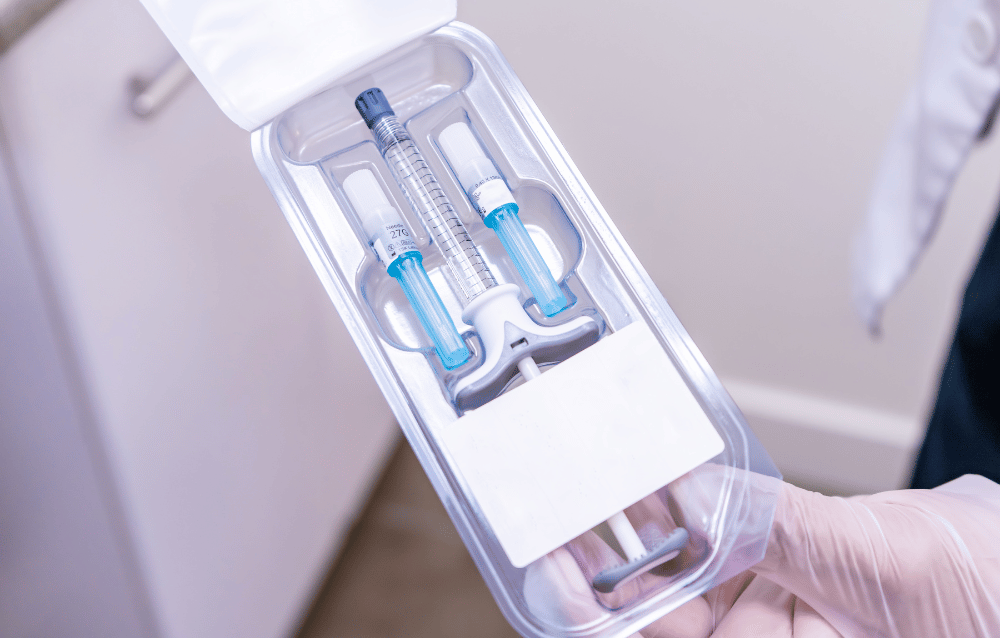How to Achieve Safe Medical Packaging for Difficult-to-Package Products
Medical
April 25, 2023Reading time: 3 minutes

Safe medical packaging is both a goal and challenge for medical manufacturers. The variety of medical devices and specificity of requirements makes each packaging solution unique — and sometimes difficult.
Overcoming the obstacles starts with understanding how devices may pose risks to medical packaging, and how an experienced packaging partner can help mitigate or eliminate those risks.
Primary causes of medical device packaging difficulties
Medical devices may be difficult to package because of physical characteristics, barrier requirements, and/or processing complexities.
Size, shape & weight
Medical devices come in a range of sizes, weights, and shapes. Each can be uniquely complex in terms of packaging. For example, an endoscopic stapler has a long arm, rotating sharp stapling attachments, and a battery-weighted trigger handle. To address all of the device’s needs, packaging may require thicker-gauge film for toughness yet flexibility to accommodate certain equipment, or a thermoformed tray to protect the delicate instrumentation by holding the device firmly in place.
The geometries of a small, lightweight medical device may not be as complex as a large one, but that doesn’t mean packaging isn’t a priority. Often, lightweight devices require additional processes or highly functional films for proper protection.
Sterilization & barriers
Regardless of the size of the medical device, sterilization processes, and barrier protection are a necessity. Aligning the sterilization method with the appropriate barrier material to prevent moisture, light, and oxygen contamination is imperative and can be multi-level. Absorbent products such as sutures, for example, typically need ethylene oxide (EtO) sterilization due to radiation sensitivity and barrier film that prevents moisture absorption. In this scenario, solutions may be either a dual-function package design or multiple packages.
Component arrangement & processing
Procedure kits need to be arranged in such a way that allows components to be accessed, assembled/presented, and used in a specific order to achieve the intended results. Packaging formats for kits — typically a thermoformed tray — may be iteratively designed to ensure proper presentation method in combination with barrier protections and easy-open container closure integrity.
Compromised packaging: 3 failure risks
Given the myriad ways devices could present packaging difficulties, there isn’t a sole focus for preventing failure such as container closure integrity. Medical packaging could be compromised through:
- Puncture or flex cracks if device geometries include something that may poke through packaging such as an articulating arm or sharp edge, or if weight is such that any shifting may cause packaging cracks
- Abrasion which could slit or rip packaging and expose the device to contamination. Secondary packaging (usually cartons or shippers) can also cause abrasion — an additional consideration for manufacturers in terms of protection, perhaps meaning the use of tougher films or slip sheets
- Open seals are an obvious breach of medical device sterilization and product integrity
These vulnerabilities are typically exposed during manufacturer ship tests where packaging is exposed to extreme handling conditions to understand performance; packaging that does not execute all key functions is an automatic failure. Manufacturers working with a packaging supplier that provides extensive in-house materials expertise and testing have an added measure of failure risk mitigation.
More packaging, more protection?
When a medical device is awkwardly shaped or presents another characteristic that challenges packaging formats, common logic is to pursue a solution that is either over-engineered or over-sized to ensure safety.
More isn’t always better. Consulting with a packaging partner keeps manufacturers from applying past learnings, data, or formats that may be too sophisticated for the need. Likewise, over-sizing — a less common approach — could mean devices shift in transit or package corners fold causing possible damage or contamination.
Over-engineering or over-sizing can also lead to higher costs and environmental consequences such as a greater carbon footprint or higher emissions. Working with an experienced packaging supplier — especially one with a portfolio of recycle-ready options — is the best way to balance safety, protection, and sustainability.
How Amcor helps
Packaging that performs is a collaborative process between Amcor engineering experts and medical manufacturers. Working together toward a solution requires clear, ongoing communication and access to capabilities that support ideation and innovation, including:
- Rapid prototyping and iterative sizing
- Custom packaging design and tooling that can be manufactured in real-world scenarios
- A wide portfolio of high-performance and recycle-ready materials with characteristics that support complex medical device packaging
Safe medical packaging for difficult to package products is a combination of materials, performance, usability, and presentation guided by an experienced packager to ensure device integrity and patient safety. Get the facts you need to find the solution and partnership you need to succeed in The Insider’s Guide to Sterile Barrier Packaging.

